Turkish Semolina Halva, also known as irmik helvasi, is a traditional Turkish dessert that is incredibly easy to make. Toasted pine nuts and semolina come together in a pan and then they are combined with a sweet syrup. So yummy!
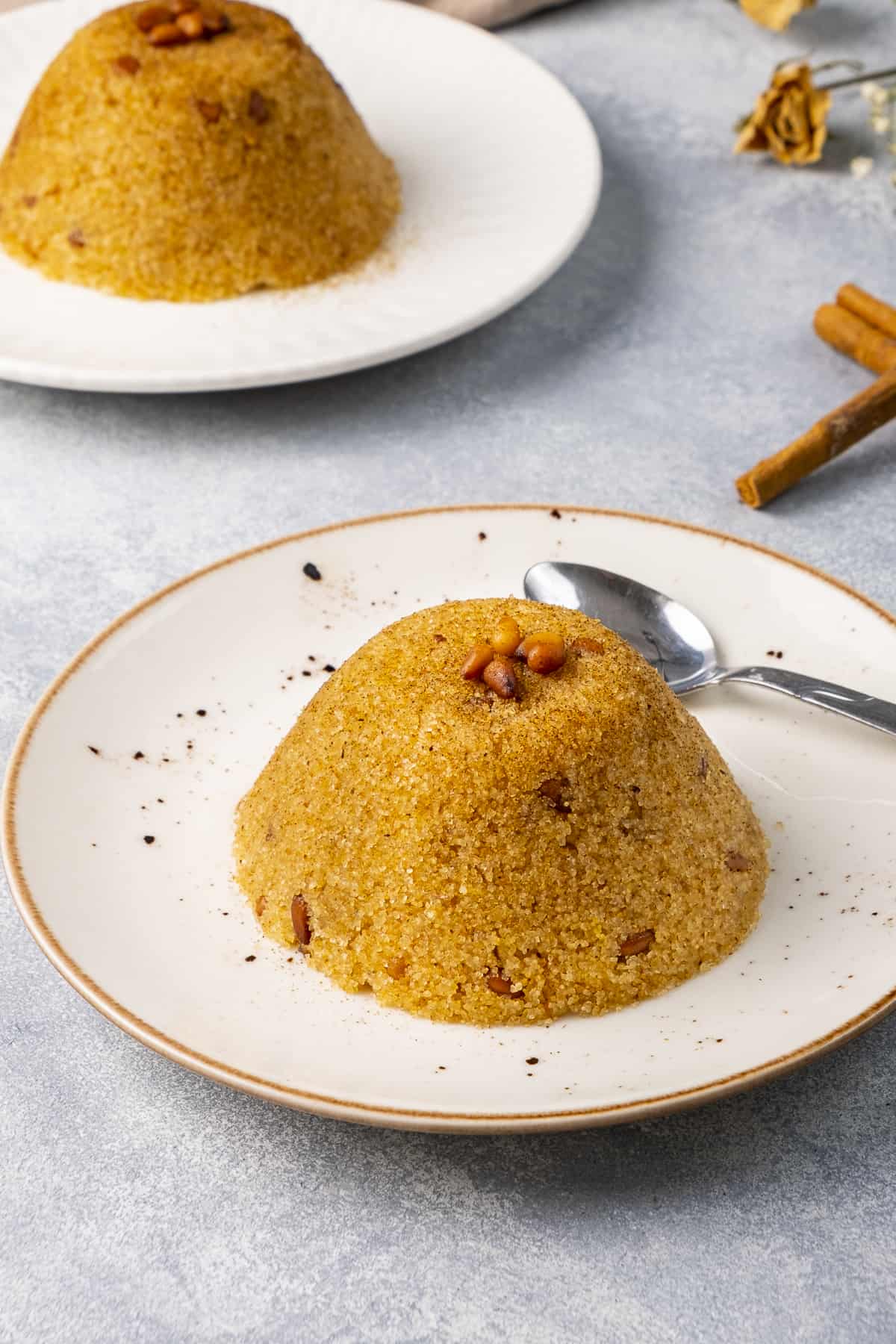
This semolina pudding is one of the easiest Turkish desserts that can be made with a few simple ingredients. Everyone in Turkey has a memory of irmik helvasi and their grandmas, who are known as the halva expert in the family. So people learn the recipe from them.
Jump to:
What Is Irmik Helvasi?
Turkish halva, also spelled halwa or halvah, is a traditional dessert in Turkey. It is served on occasions such as births, religious holidays like Ramadan, and funerals.
Irmik Helvası is just one type of traditional halva recipe in Turkish cuisine. There are three different kinds you can find.
The first is semolina halva or irmik helvasi as we say in Turkish. It is a traditional Turkish dessert made primarily from semolina (irmik in Turkish), sugar, and butter, often enriched with pine nuts. It's cooked until golden brown and can be served warm or cold.
The second is flour halva (un helvasi). It uses plain flour instead of semolina and known as the oldest and cheapest dessert in Turkish culture. This is an easy recipe because you only need about 4 ingredients: Butter, flour, sugar and water.
Finally, the third type of halva in Turkey is Tahini Halva (Tahin Helvasi), which is made from sesame seed paste, tahini. This version is always bought from stores as it is a kind of candy and not easy to make at home. The most popular brand you can find online is Koska Tahini Helva.
About The Ingredients
Today's halva recipe with semolina is easy to make. You only need a few ingredients, but there are other variations you can check out below.
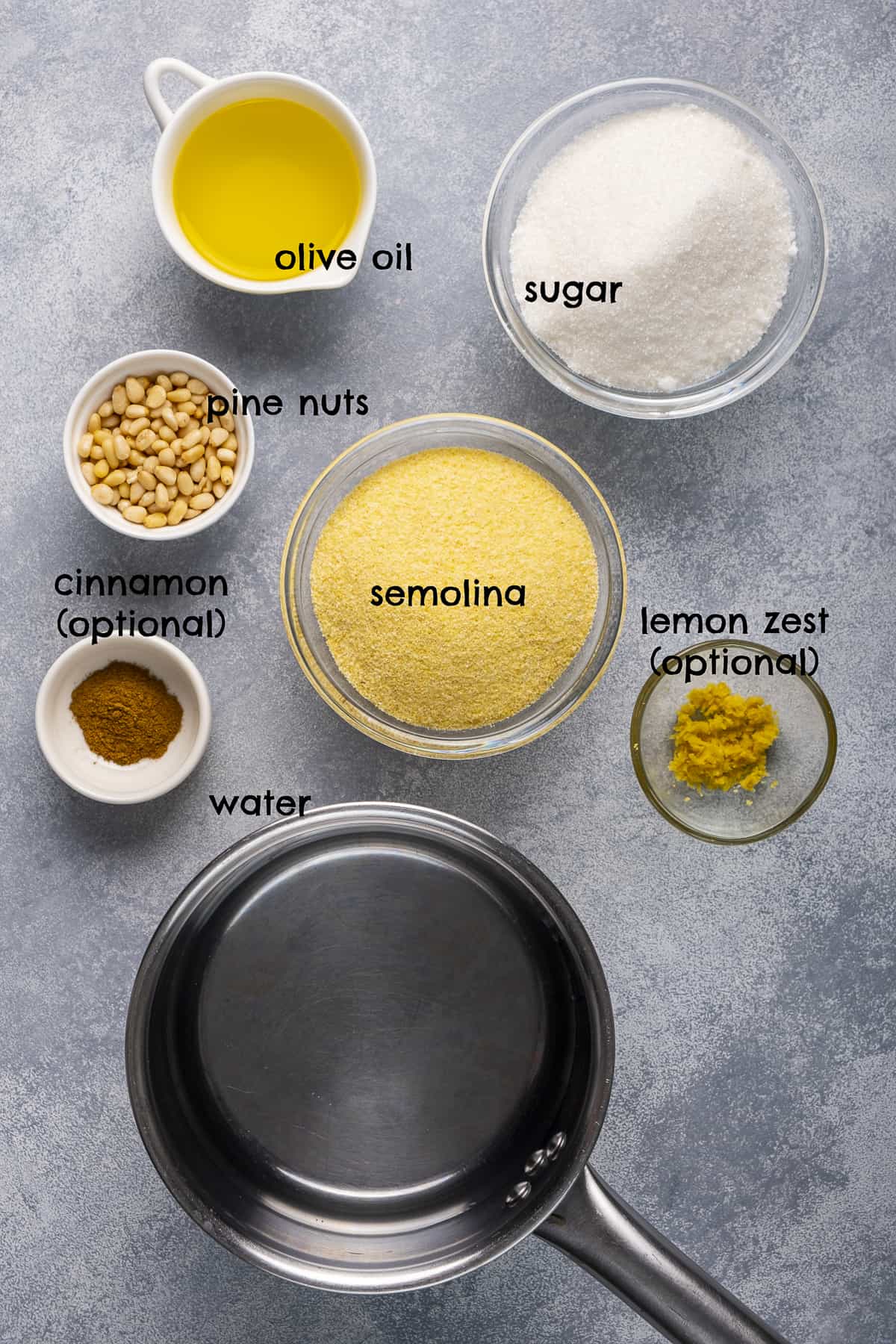
- Semolina (irmik): Also known as semolina flour. It is a type of textured flour made from durum wheat. You get a few different textures, mainly fine and coarse. You can use either for this recipe. But semolina isn’t replaceable when making irmik helvasi. It is a staple in Turkish dessert recipes and is also used to make desserts like semolina cake revani, sekerpare and Turkish tulumba.
- Oil: We use light olive oil, but you can use vegetable oil or sunflower oil too. Authentic semolina helva is made with butter instead of oil. So, you can do this as well. But for a lighter taste (which is what we prefer), we use olive oil.
- Pine Nuts: Traditional irmik helvasi is made using pine nuts. It is toasted just like in our Middle Eastern rice recipe. You can also use walnuts or almonds when making helva.
- Sugar: In the Turkish version of this dessert, we use only sugar and no other alternative. There is a Greek version of semolina halva called semolina pudding that replaces a bit of sugar with honey.
- Water: There are two versions of semolina halva in Turkish cuisine. One is made with only water, and the other with a combination of water and milk in a one-to-one ratio. You can find how to make the milk version below. But personally, we prefer the one made with water only. It’s a matter of preference.
Optional Add-Ins
Here are a couple of ingredients you can add to your irmik helvasi.
- Lemon zest: Adding lemon zest is completely optional. But we do like the zesty fresh flavor it adds to the semolina.
- Raisins or currants: Right before you add the water to the mixture, you can add a cup or so of raisins or currants. These will add a slight sweetness but predominantly some texture.
- Cinnamon powder: Cinnamon powder is a topping used for semolina halva. You can use it in combination with other toppings.
- Ground Pistachio: Finally, ground pistachios are also popular toppings. Again, if you use an alternative type of nut, you can use it in its ground form as a garnish as well.
How To Make It
Today, we will show you how to make the authentic Turkish semolina halva dessert recipe in less than 30 minutes. It is easy, but you should follow our in-depth steps and tricks to get it perfect. This irmik helvasi is packed with sweet, nutty flavors and rich, creamy textures.
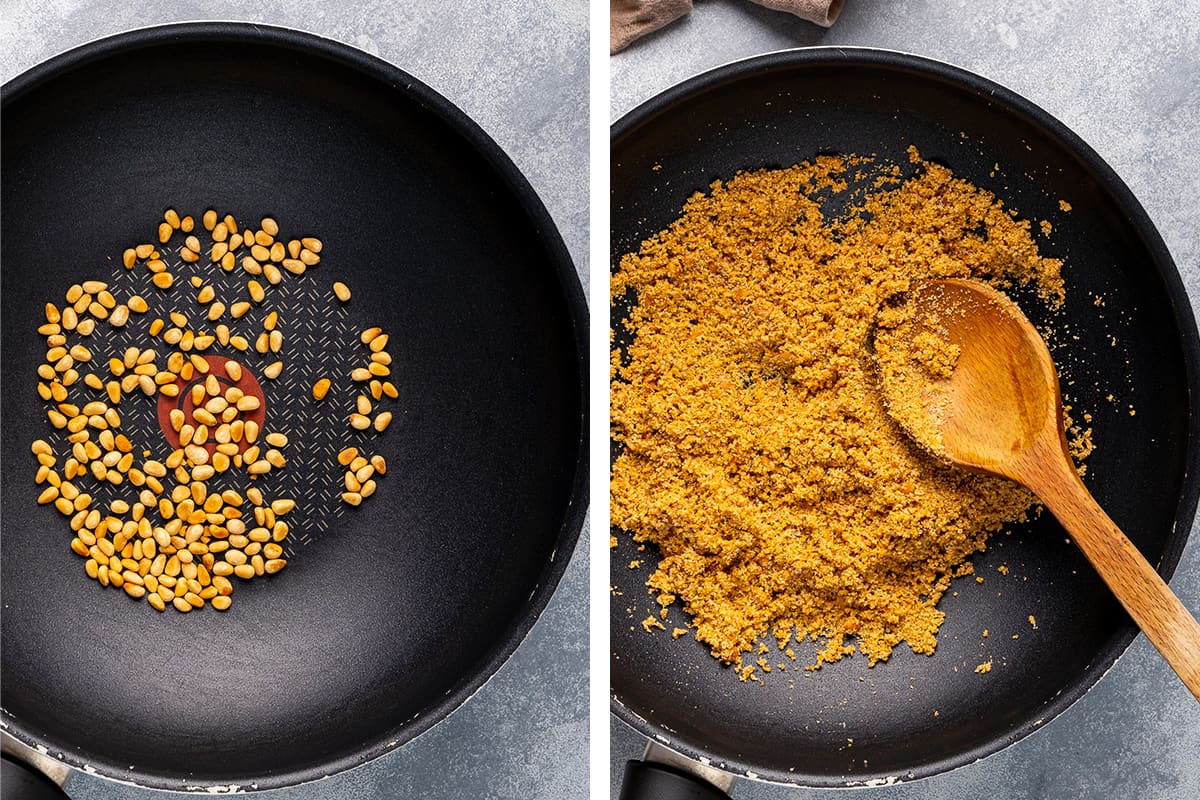
- Toast the nuts. To start, heat a non-stick frying pan over medium heat. Add the pine nuts and allow them to toast for a couple of minutes. Brown spots will start developing on their surfaces.
- Add the oil and semolina. (If you use butter instead of oil, add semolina when the butter melts). Give them a good stir so that they blend with the pine nuts. Then, cook over medium heat for about 8 minutes or until the color of the semolina turns to golden brown. Make sure to stir the mixture constantly as semolina burns easily.
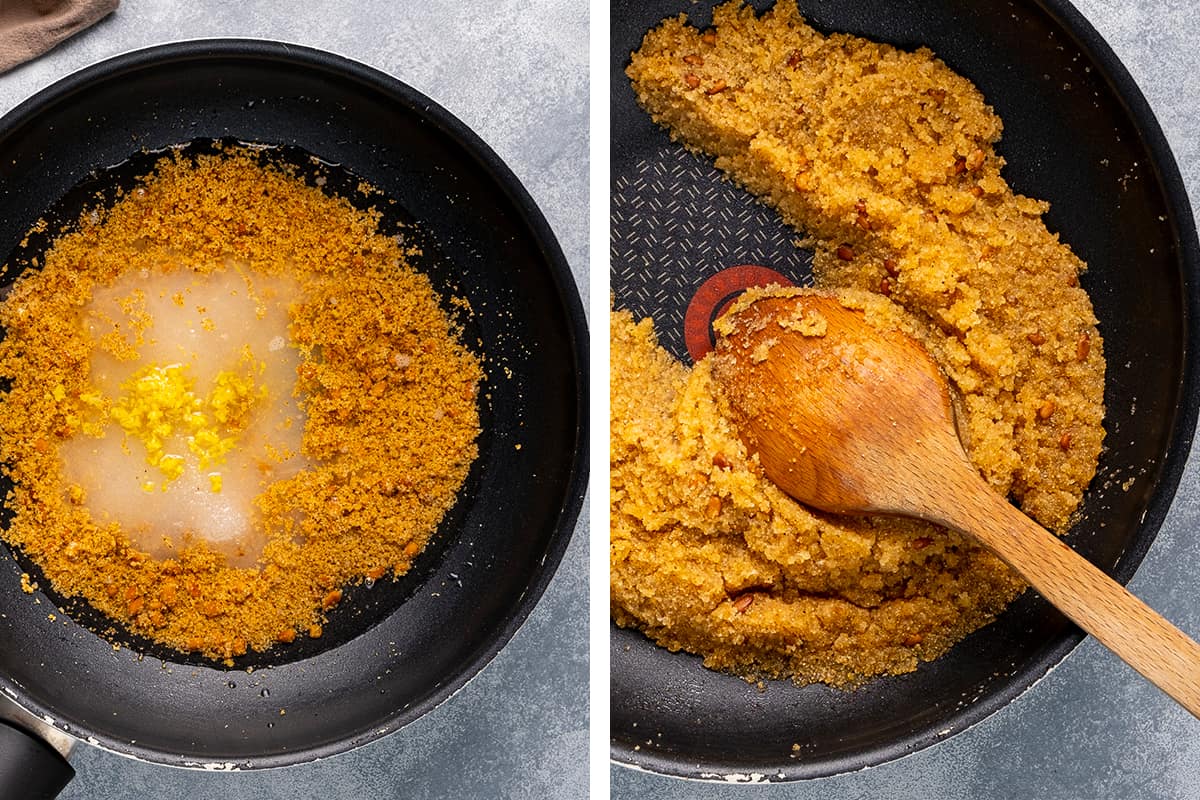
- Add in lemon zest (if you are using), sugar and water at the same time. Give it a stir and cook it covered until it boils.
- Once the halva dessert mixture starts boiling, lower the heat as low as it can go. Leave the mixture to cook covered until all of the water has been absorbed. It will take roughly 3-4 minutes.
- Rest and cool the halva. Once it has thickened, remove it from the heat and leave the halva to rest for 15 minutes.
- You can serve irmik helvasi cold, at room temperature or warm. So, cool it as you need to.
- You can serve this semolina dessert in a bowl or turn it upside down onto a plate. Then, sprinkle over some ground cinnamon for garnish.
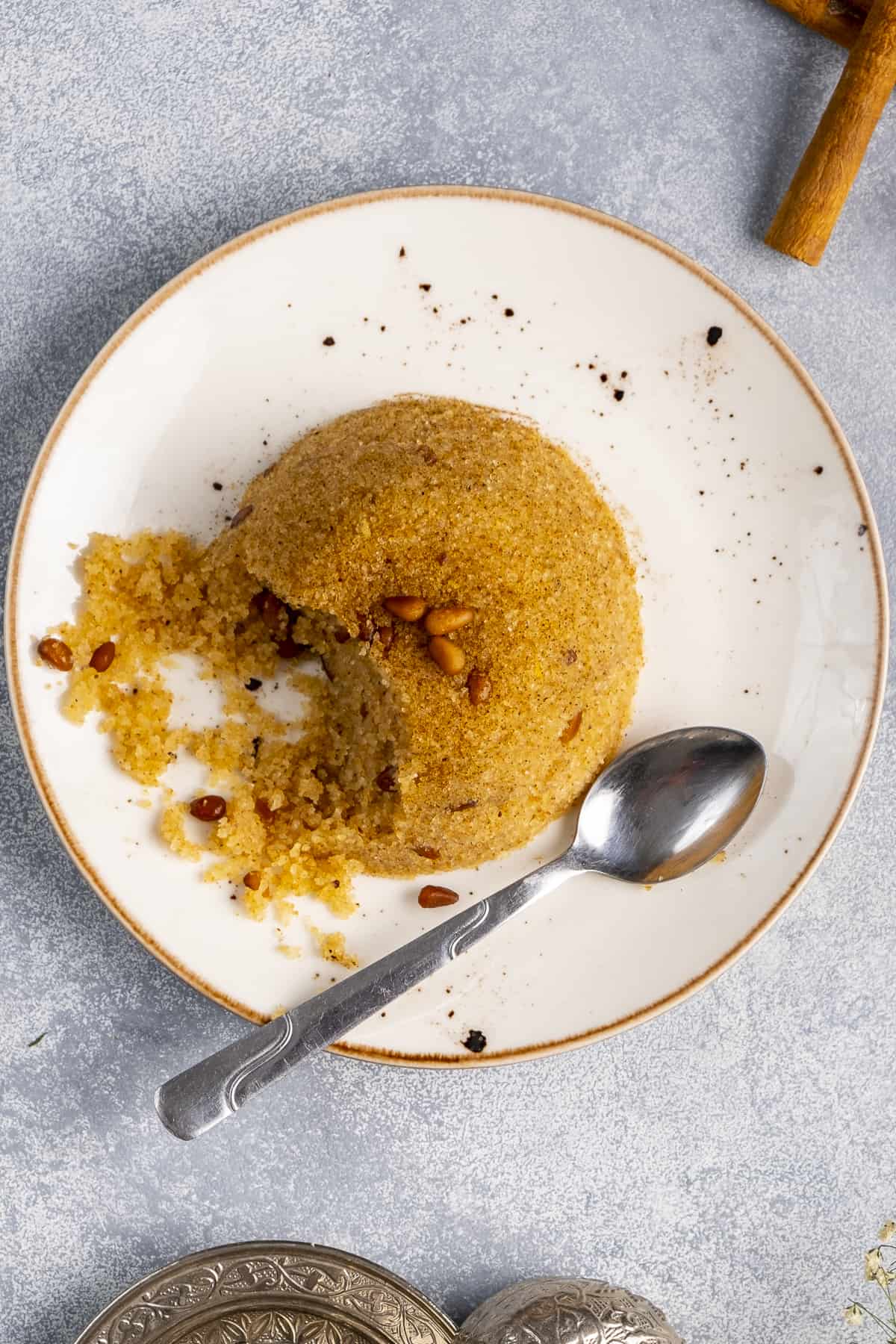
Turkish Semolina Halva With Milk
If you would like to make semolina helva with milk (Sütlü İrmik Helvası), you can follow the steps below.
- Make your syrup by combining the milk, water, and sugar in a saucepan. Cook these ingredients until the sugar dissolves. Remove it from the heat and set it aside.
- Cook the pine nuts and semolina as described in our recipe.
- Once the semolina is golden, lower the heat and gently pour in the milk syrup. Stir it in well.
- Bring the halva base to a boil. Once it boils, leave it to cook over the lowest heat for about 3-4 minutes.
- Proceed to cool and serve the Turkish semolina helva as the recipe states.
Halva With Cheese Addition
There is a cheesy version of Turkish semolina helva recipe that is famous in Hatay (Antakya), a city in the south of Turkey. Just like in the Turkish kunefe recipe, an unsalted, easy-to melt cheese is added in the halva and you have one of the most delicious desserts ever.
The traditional cheese used here is produced in the same city and it is definitely not easy to find abroad. However, you can substitute mozzarella for it.
So if you want to add cheese in your irmik helvasi, add ½ cup shredded mozzarella into the pot right after the syrup is absorbed. Give it a stir and remove from the heat. Let it rest covered for 10-15 minutes and serve it warm.
How To Serve It
There are three ways to serve Turkish semolina halva.
- Serve it in small bowls.
- Get spoonfuls of semolina helva and drop them on a plate. You can use two spoons; one to hold the halva and the other to slide it on the plate. They have a smooth shape this way.
- Give it a dome shape by filling it in a bowl and then turning it upside down on a plate.
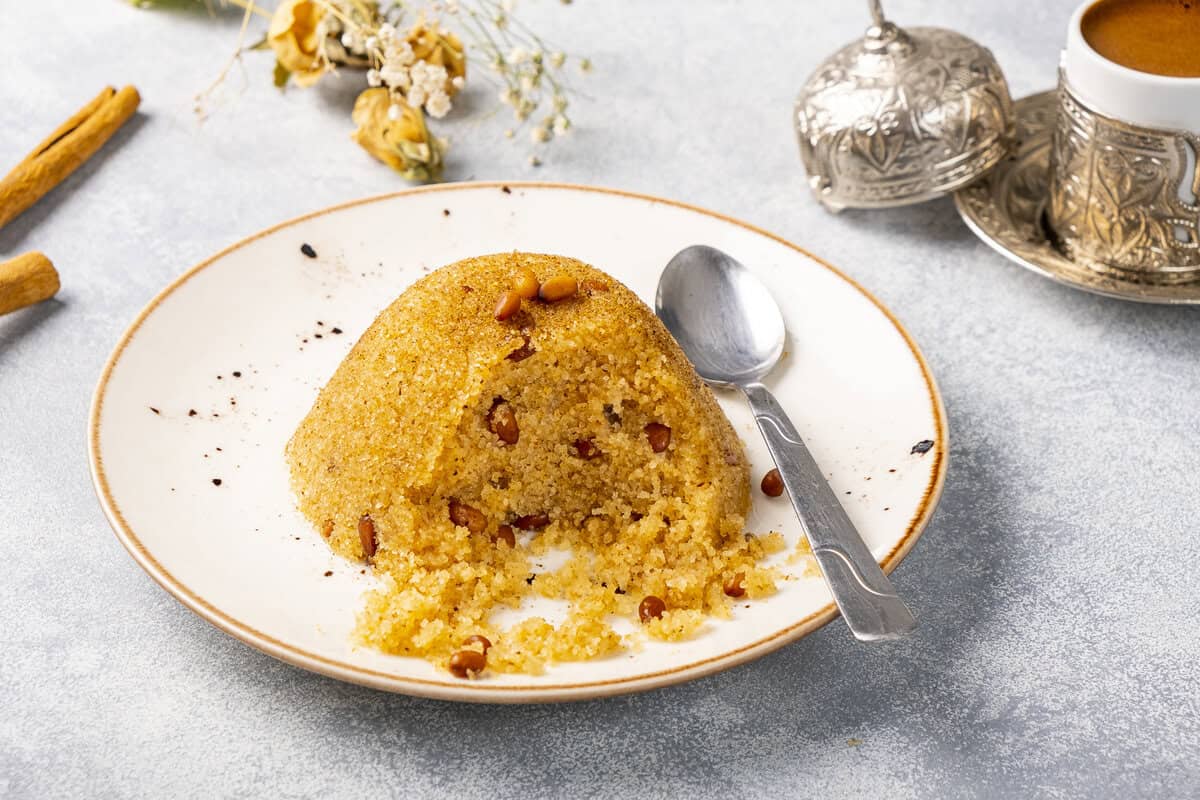
Irmik helvasi can be served cold, at room temperature, or warm. So, when cooling it, make sure you don’t overdo it.
For garnish or accompaniment ideas, we highly recommend serving halva with a scoop of ice cream, especially with Maraş dondurması (Turkish ice cream). You can also serve it with Turkish kaymak (clotted cream).
And, of course, you should try it with homemade Turkish coffee or authentic Turkish tea!
How To Store It
You can store this Turkish semolina halva at room temperature for one day. If you store it properly inside the fridge, it will even last up to a week!
Keep it inside an airtight container to help preserve its flavor and texture.
Do not freeze halva. It doesn't keep well, and won't be as good as when made fresh.
Our Tips
- This semolina halva recipe should be constantly monitored. Do not walk away from the stove. Semolina can burn very quickly after it has been heated for a while. So, stir it constantly until it is golden or a light shade of brown. Just follow our steps and cooking times in the recipe card below.
- Pour the water into the saucepan very carefully. Because the semolina is hot, it may spill over and burn you.
- Irmik helvasi has to sit for 15 minutes before you serve it. This step helps develop a better texture and flavor.
More Turkish Desserts
As always: If you make this recipe, let us know what you think by rating it and leaving a comment below. And post a pic on Instagram too—tag @give_recipe so we can see!
Sign up for the FREE GiveRecipe Newsletter to get the new recipes into your inbox! And stay in touch with us on Facebook, Pinterest, YouTube and Instagram for all the latest updates.
📖 Recipe

Irmik Helvasi - Semolina Halva Turkish Way
INGREDIENTS
- 3 tablespoons pine nuts
- 80 ml olive oil
- 200 grams semolina
- 1 teaspoon lemon zest optional
- 225 grams sugar
- 350 ml water
- ½ teaspoon cinnamon optional
INSTRUCTIONS
- In a non-stick pan, toast the pine nuts over medium heat until you see brown spots on them.
- Add in olive oil and semolina. Cook over medium heat, stirring constantly until it gets golden, for 8 minutes.
- Add in lemon zest (if you are using), sugar and water. Give it a stir and cook covered until it boils.
- Once it starts to boil, reduce the heat to the lowest and let it cook until all the water is absorbed. This might take 3-4 minutes.
- Remove from the heat and let it rest for 15 minutes.
- Share it into bowls, gently pressing on them and let them cool.
- Serve it warm, at room temperature or cold.
- Either serve it in bowls or turn the bowls upside down on a plate to give it a dome shape.Sprinkle cinnamon on it and serve.
NOTES
- If you are using butter instead of oil, let it melt in the pan before adding semolina.
- You shouldn’t leave the pan when cooking this helva. After reaching a certain temperature in the pan, semolina might burn very quickly. So you should keep an eye on it and cook stirring constantly. We want the semolina to get golden or very light brown. If you follow the steps with their time in the recipe card below, everything will be fine.
- Be careful when pouring water into the pan once the semolina in it gets golden. As the pan is really hot, water might spill.
- Don’t serve it before letting the helva sit for 15 minutes. The texture will get better and the flavors will bend better.
- Semolina Halva With Milk (Sütlü İrmik Helvası):
- If you want to make your halva with milk, you need to make a syrup first. Combine milk, water and sugar in a saucepan. Cook over medium heat until the sugar dissolves. Remove from the heat.
- Cook the pine nuts and semolina as described in the recipe. When the semolina gets golden, reduce the heat and pour this milky syrup into the pan. Give it a stir and bring it to a boil.
- When it starts to boil, reduce the heat to the lowest and cook it covered until the syrup is absorbed, for 3-4 minutes. Remove from the heat and let it sit for 15 minutes before serving.
NUTRITION
Nutrition information is automatically calculated, so should only be used as an approximation.
ADDITIONAL INFO
You might also like:
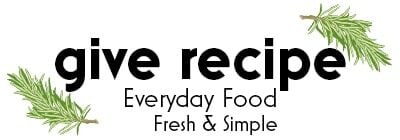

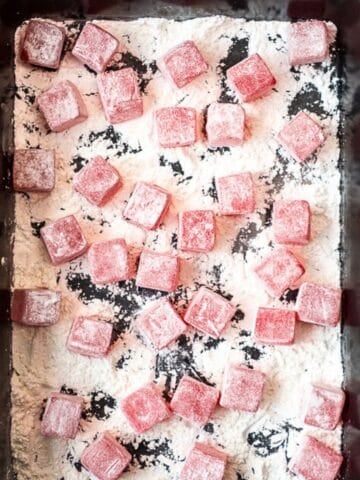
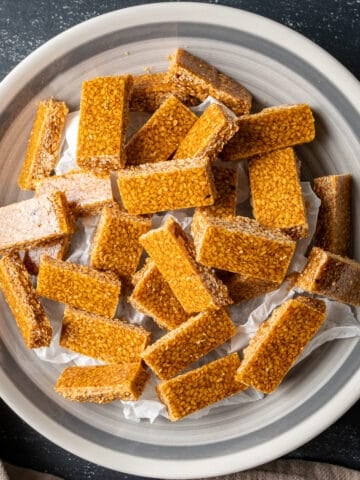
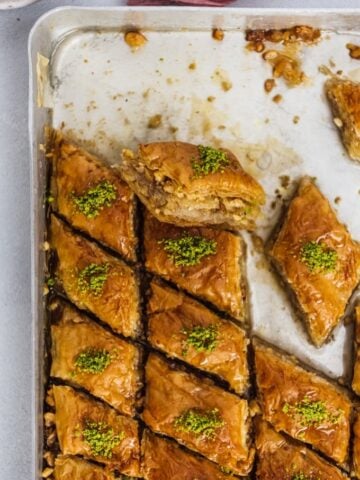
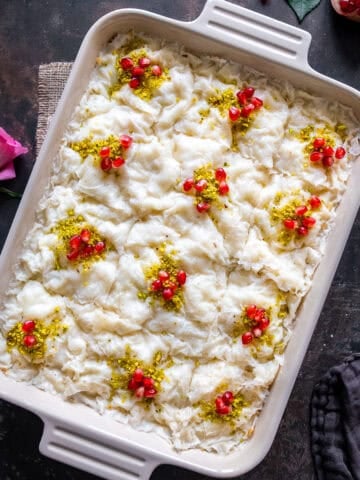
Denise says
This is how I exactly like semolina halva. With oil and pine nuts. Thank you for the recipe!
Zerrin & Yusuf says
Hi Denise,
Happy to hear that 🙂
Mina Joshi says
Wow - another dish we Indians love and make. This semolina halva is one of my favourites, I make it very similar to you but have never added lemon zest.
Wendy says
This looks lovely, Zerrin, and I am very happy that you used currents instead of nuts, because I am allergic to nuts! I have a question about the word "halva". Does it mean something? The middle eastern halva I am used to is made with sesame seeds and is a very firm candy. This sweet reminds me of the semolina filling in the Greek pastry galaktoboureko (my personal favorite).
Zerrin says
Hi Wendy! I'm happy that you can make this halva with currants. Halva is the name we use for desserts made with flour, semolina or sesame seeds. In its origin, halva was used in place of the word dessert. Now we have 3 types of halva. Tahini halva, one you know, which is very firm; semolina halva and flour halva. Never heard of galaktoboureko, must search for it!
Reeni says
This looks so elegant and special Zerrin! Especially so when made by Grandmas. I like the mix of flavors you infused into it - irresistible!
Zerrin says
Thank you Reeni! Grandmas always know the best! Lemon zest and currants were definitely perfect and I guess my grandma would be proud of me!
Ilke says
Nice looking halva! So inviting. We used to make it in the middle of the night when we were back in college and pulling all nighters. No wonder we stayed up till morning with that sugar rush 🙂
Zerrin says
I don't know how, but we crave for it at nights too! I'm sure my neighbors would get angry with me if I made these at night. Its smell becomes more tempting in the middle of night!
lisaiscooking says
Your updates to the traditional version sound lovely. Sauteeing the semolina in butter must smell delicious as it cooks!
Rosa says
A delicious treat! That is something I'll have to make very soon...
Cheers,
Rosa
Chris at Hye Thyme Cafe says
Funny timing - I have only ever had the pine nut version (known to me as Imrig Halva), but I was also thinking about a new version ... I received a sample of chocolate Cream of Wheat in the mail, and that was the first thing I thought of. Trying a chocolate version - maybe with almonds. I love the idea of the currants in this one, and that would give me something to use them in besides scones and stuffed grape leaves. 🙂
Zerrin says
Chris, chocolate version of irmik halva sounds great! Almonds would be a perfect addition too! I love currants in dolmas and stuffed grape leaves or in rice pilaf, but I used them in this halva for the first time and the result was so pleasing!
TasteofBeirut says
Very pretty and so delicious! I like this with cheese interlaced with it!
Zerrin says
Joumana, I remember now that I ate a kind of semolina dessert with unsalted cheese at a kebab restaurant, and it was fantastic! I must search for its recipe now!